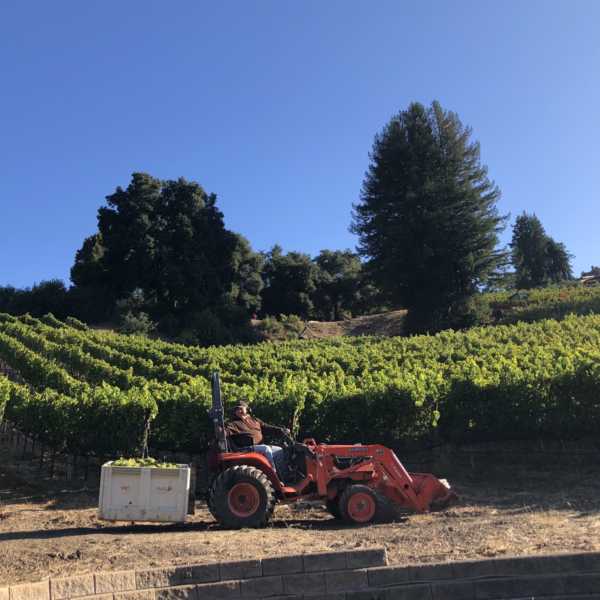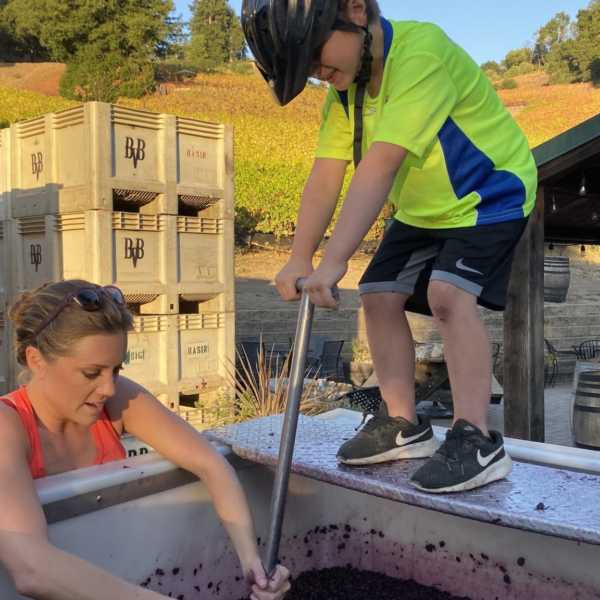Big Basin Vineyards is terraced into a steep hillside first planted to grapevines by French immigrants more than 100 years ago. Our estate and our carefully selected partner vineyards are all located at sites in the Santa Cruz and Gabilan Mountains that are as beautiful as they are exceptional for grape growing. We farm organically, time our harvests to capture intensity and elegance, and practice minimal-intervention winemaking. Our goal is to produce aromatic and ethereal wines that transparently and authentically express terroir and variety.
The Big Basin Vineyards Story
“Proprietor Bradley Brown crafts some of the most compelling, small-production artisan wines in California’s Central Coast. With each passing year, the wines are more refined and polished, making Big Basin one of the most dynamic up-and-coming wineries in the state.”
Meet Our Founder & Owner
Bradley Brown
Bradley is our founder, vineyard manager, and guide, uncompromising in his commitment to producing authentic and compelling wines, farming organically, and working with the best vineyard sites throughout the Santa Cruz and Gabilan Mountains.
Bradley was drawn to California post college for the natural beauty of the Sierras where he climbed, backpacked, and skied. He gradually made his way down the peninsula to Portola Valley and eventually to Boulder Creek in the heart of the Santa Cruz Mountains.
Under the guidance of Rhône Ranger John Alban, Bradley planted our Rattlesnake Rock Estate vineyard in 2000, vinified our first vintage in 2002, and built our winery in 2003 using redwoods sustainably harvested from the Estate.
Bradley presently serves on the Board of Directors for the Santa Cruz Mountain Winegrowers Association. He lives on the property with his two young sons, Kiran and Lakota, both of whom love grapes and tractors.
Team
Our Historic Estate
Building Upon a Pioneer Tradition

In the 19th century, enterprising settlers identified the few locations in the Santa Cruz Mountains that were suitable for planting grapes, apples, and olives. They clear-cut the land, then used dynamite to remove tree stumps.
Our property was one of these sites, with the burnt-out tree stumps to prove it. Agave plants and quince, plum, and walnut trees still remain from the 1880s, when it was first homesteaded.
Three French settlers purchased this land in 1906, planted grapes, and made wine until Prohibition was enacted in 1920. In 1935, Justin Lacau, another Frenchman, acquired the property, naming it “Frenchie’s Ranch.” In 1967, Lacau sold the estate to a San Jose timber family, who logged it several times.

When Bradley Brown purchased “Frenchie’s Ranch” in 1998, it was severely neglected. The old homestead—a cabin on the site of the current winery building—had burned to the ground in the 1970s. Area residents used the site as a dumping ground for old vehicles, and local teenagers congregated there for clandestine parties.
Before establishing the current vineyard, Bradley undertook a significant cleanup and engineering of the property to stabilize the slopes and manage the significant runoff that occurs during the rainy season. Cuttings were taken from the original vines and planted in front of the winery.
While clearing the 10-foot-high poison oak and brush and removing large boulders from the vineyard, we encountered a rock too large to move. The deeper we dug around it, the larger it appeared, so the contractor suggested a hydraulic ram to break it up. Two hours later, barely four inches had been chipped away. Since this rock was here to stay, we dragged and pushed the other successfully cleared boulders on top of it, creating what is now known as Rattlesnake Rock. And yes, just like our pioneer predecessors, we do occasionally see rattlesnakes.

Our winery building was completed in December 2003 on the same site as the original 1890s cabin and winery. It is a ‘Monitor’-style barn with a timber frame construction built using redwood selectively harvested from the estate.

While the style of building is historic, it is built to be highly energy-efficient and ideal for artisan winemaking. The first floor is temperature-regulated for controlled barrel aging and fermentations.
Bradley also built his own house at the top of the property using our own redwoods, and we hosted many joyful tastings and dinners there over the years. Unfortunately, in the 2020 CZU Lightning Complex Fire, Bradley’s house was destroyed. We are grateful that the winery and vineyard emerged more or less unscathed, but we mourn the loss of a place that created many happy memories for our community.
The Story of the Big Basin Family
Meet the Browns
For us, the Big Basin Vineyards story started almost 50 years ago, when Glenn Brown, the father of the three Brown family siblings, became an avid home winemaker in upstate New York. According to our somewhat hazy memories, Glenn managed to make drinkable wines using Finger Lakes varietals such as Marechal Foch and Baco Noir.
Derek, the eldest Brown sibling, developed his wine knowledge during the seven years he spent living in France (he’s standing, at right, in the photo below, shot circa 1975).

Derek took time off his office job to work the 1994 harvest at Château des Tours in the Rhône Valley (Vacqueyras). Wendy also expanded her horizons on a several-month bicycle tour of the French wine regions. (Burgundy was her favorite.)
Bradley, the youngest, was the one with the idea—and the energy—to turn the family passion into a business. After chasing his own travel dreams and working in tech in California, Bradley bought the land which would become our Estate vineyard, restored it, planted it, and produced our first vintage in 2002.
Derek later established our second Estate vineyard, Brokentop Ranch, which we released as a vineyard-designate bottling in 2014. The Browns have been joined by Derek’s French girlfriend, Audrey, who keeps the financial books in order and the staff from going crazy.
The extended Big Basin family—Blake, Ruthie, Doug, and Luis—are essential to the production and marketing of our acclaimed wines and to us, they are part of the Brown family. We may not all share genes, but we do share similar values: a commitment to quality, a respect for the land, and a passion for wine.












